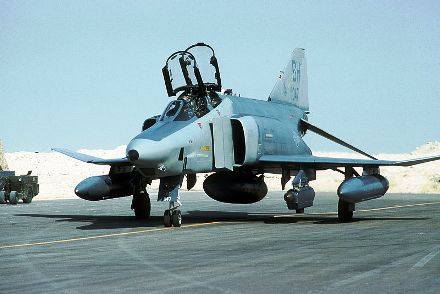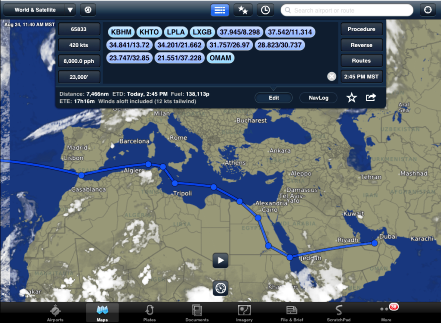BIRMINGHAM AL- Today 22 years ago, members of the 106th Tactical Reconnaissance Squad of the 117th Tactical Reconnaissance Wing departed Birmingham on a historic non-stop mission that would last over 15 hours to Al Dhafra Air Base, UAE. The units were activated after Iraq invaded Kuwait under Saddam Hussein on August 2, 1990.
USCENTAF, Rapid Deployment, dispatched the recon and tactical ready Squadron as the first to land in what was soon known as Desert Shield. Then Colonel James F. Brown, 117th Tactical Reconnaissance Wing Commander led the formation of six RF-4C Phantoms on what is believed to be the longest non-stop flight of six Phantoms in history. Capt. Joey Sanders, Pilot and Capt. Jack Tucker, WSO, at the time, crewed one of six phantoms along with two KC-10 tankers. The heavy tankers departed BHM first, Sanders recalled, their jet exhaust kicking up dirt at the end as they lifted off runway 5 at max gross.
Departing on August 24 at 1630 CDT and after each Phantom refueled in the air 16 (sixteen) times and after traveling more than 8,000 nautical miles without landing they arrived at Al Dhafra Air Base, United Arab Emirates at 1600 local time on 25 August 1990. Aerial refueling from four different KC-10's and four different KC-135's kept them airborne.
![]()
A RF-4C Phantom II, "047" from the 117th Tactical Reconnaissance Wing sits on an airfield on the first day of Operation Desert Storm. "047" is still display at the Air Force Museum in Dayton, painted in the Birmingham Air National Guard colors of the 1990 Operation Desert Shield deployment of the 106th Tactical Reconnaissance Squadron -US Air Force image.
When the pilots landed, some had to cut off their boots due to swelling from maintaining their positions in the cockpit for such an extended time. Their canopies opened to temperatures of 121 degrees at Al Dhafra Air Base. Sanders remembers the runways and buildings were same color as the sand making them near indistinguishable from the terrain. Sleeping in tents and eating MREs, it was scorching hot days and cool clear nights for the crew on the desert.
![]()
Al Dhafra Air Base (ICAO: OMAM) is a military installation in the United Arab
Emirates. The base is located approximately 20 miles south of Abu Dhabi. The historic 106th Tactical Reconnaissance Squadron's Phantom flight is re-enacted with ForeFlight.
Desert reconnaissance lasted four months while other squadrons joined in and took their positions until the mission was completed.
Of the six Birmingham phantoms on the original mission, one was lost in the Gulf during Desert Shield claiming two 106th crewmembers, Maj B.K. Henderson, Pilot and Lt Col Steve Schram, WSO. A second, flown by the Reno Air Guard, was lost in the Gulf in 1991 during Desert Storm with the crew surviving. The third caught fire and was lost off the coast of Savannah, GA later during training exercises.
The last operational RF-4C squadron flight, May 1995, was piloted by the future 117th Air Refueling Wing Commander, Lt Col Evans Whaley. Aircraft "047" is still on display at the USAF Museum, painted in the Birmingham Air National Guard colors of the 1990 Operation Desert Shield deployment of the 106th Tactical Reconnaissance Squadron. Another surviving RF-4C Phantom is located in Jasper, Alabama, #65833 is positioned at the VFW Post 4850. The remaining one is in a desert bone yard at Davis Monthan AFB. It all began 22 years ago today. -B Meyer
USCENTAF, Rapid Deployment, dispatched the recon and tactical ready Squadron as the first to land in what was soon known as Desert Shield. Then Colonel James F. Brown, 117th Tactical Reconnaissance Wing Commander led the formation of six RF-4C Phantoms on what is believed to be the longest non-stop flight of six Phantoms in history. Capt. Joey Sanders, Pilot and Capt. Jack Tucker, WSO, at the time, crewed one of six phantoms along with two KC-10 tankers. The heavy tankers departed BHM first, Sanders recalled, their jet exhaust kicking up dirt at the end as they lifted off runway 5 at max gross.
Departing on August 24 at 1630 CDT and after each Phantom refueled in the air 16 (sixteen) times and after traveling more than 8,000 nautical miles without landing they arrived at Al Dhafra Air Base, United Arab Emirates at 1600 local time on 25 August 1990. Aerial refueling from four different KC-10's and four different KC-135's kept them airborne.

A RF-4C Phantom II, "047" from the 117th Tactical Reconnaissance Wing sits on an airfield on the first day of Operation Desert Storm. "047" is still display at the Air Force Museum in Dayton, painted in the Birmingham Air National Guard colors of the 1990 Operation Desert Shield deployment of the 106th Tactical Reconnaissance Squadron -US Air Force image.
When the pilots landed, some had to cut off their boots due to swelling from maintaining their positions in the cockpit for such an extended time. Their canopies opened to temperatures of 121 degrees at Al Dhafra Air Base. Sanders remembers the runways and buildings were same color as the sand making them near indistinguishable from the terrain. Sleeping in tents and eating MREs, it was scorching hot days and cool clear nights for the crew on the desert.

Al Dhafra Air Base (ICAO: OMAM) is a military installation in the United Arab
Emirates. The base is located approximately 20 miles south of Abu Dhabi. The historic 106th Tactical Reconnaissance Squadron's Phantom flight is re-enacted with ForeFlight.
Desert reconnaissance lasted four months while other squadrons joined in and took their positions until the mission was completed.
Of the six Birmingham phantoms on the original mission, one was lost in the Gulf during Desert Shield claiming two 106th crewmembers, Maj B.K. Henderson, Pilot and Lt Col Steve Schram, WSO. A second, flown by the Reno Air Guard, was lost in the Gulf in 1991 during Desert Storm with the crew surviving. The third caught fire and was lost off the coast of Savannah, GA later during training exercises.
The last operational RF-4C squadron flight, May 1995, was piloted by the future 117th Air Refueling Wing Commander, Lt Col Evans Whaley. Aircraft "047" is still on display at the USAF Museum, painted in the Birmingham Air National Guard colors of the 1990 Operation Desert Shield deployment of the 106th Tactical Reconnaissance Squadron. Another surviving RF-4C Phantom is located in Jasper, Alabama, #65833 is positioned at the VFW Post 4850. The remaining one is in a desert bone yard at Davis Monthan AFB. It all began 22 years ago today. -B Meyer